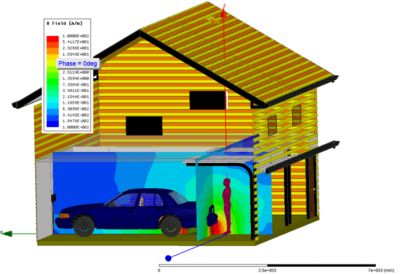-
-
学生向け無料ソフトウェアにアクセス
Ansysは次世代の技術者を支援します
学生は、世界クラスのシミュレーションソフトウェアに無料でアクセスできます。
-
今すぐAnsysに接続!
未来をデザインする
Ansysに接続して、シミュレーションが次のブレークスルーにどのように貢献できるかを確認してください。
国および地域
無料トライアル
製品およびサービス
リソースとトレーニング
当社について
Back
製品およびサービス
ANSYS BLOG
June 16, 2016
What is Wireless Power Transfer (WPT)?
Wireless power transfer (WPT) is much researched and discussed in the context of IoT, electric vehicles and mobile electronic devices. The methodology of powering a device without a physical connection is well known. However, designing the coil shapes and their placement, maximizing efficiency and validating behavior at the system level still represent challenges that cannot be achieved without simulation. The next frontier to be explored is extending and applying wireless power transfer systems to more applications, such as continuous charging of multiple devices, increasing the range of efficient power transfer and ensuring the WPT system design meets regulatory guidelines.

Wireless power transfer
The most common types of WPT utilize inductive coupling or magnetic resonance methods. Each has its strengths and weaknesses. The most familiar technology — and one that is already in use in a number of household devices, such as electric toothbrushes and cordless phones — utilizes the inductive coupling method. However, inductive coupling is not very suitable for applications that involve significant power transfer over a distance. The magnetic resonance technique is applied in two ways: the transmission of large power to distances less than a meter (typically) or the transmission of power to far greater distances than the inductive coupling method.
Electromagnetic Field Simulation
Developing a design for a reliable WPT, regardless of the method, depends on being able to model the electromagnetic and thermal performance of the coil antenna, as well as the circuitry and the logic that drives and controls system operation. Ansys Maxwell is applied to analyze low-frequency inductive coils used in the inductive coupling method. This tool also can extract the frequency-dependent equivalent R, L and C characteristics of the coils, so the engineer can construct an equivalent circuit model of an inductive coil antenna. Resonance is then achieved through the addition of an external capacitance. For magnetic-resonance-type WPT over a large distance, operating frequencies are higher, and Ansys HFSS allows engineers to determine the transmitted, reflected and total electromagnetic field of a transmit-and-receive coil antenna. HFSS also optimizes the coil design to fully take advantage of the phenomena.
Parametric Analysis and Optimization
Engineers can leverage the powerful parametric analysis features in Maxwell to automatically vary coil size, position, material and gap to converge on the optimal coil design. Maxwell’s parametric analysis is also ideal for evaluation of shielding effectiveness. Materials and geometric parameters such as thickness and shape can be variables within the simulation that provide engineers with valuable insight into the shield design and its ability to limit the electromagnetic field strength at a given distance.
Multiphysics
Thermal analysis is another important aspect of WPT systems, especially high-power systems such as electric vehicle charging or enclosed electronics devices. Temperature has a strong impact on the efficiency of the wireless transformer, since electromagnetic properties, e.g., conductivity and permeability, are temperature dependent. An increase in temperature can decrease conductivity, thus generating more heat dissipation and decreasing the overall efficiency. Core materials used in these devices can completely lose their magnetic characteristics when the temperature is higher than 150 C.
Additionally, high temperatures pose safety concerns. Finally, if thermal stress is a concern, then one must first know the temperature field before thermal stress calculations can be performed. Therefore, when doing simulation for wireless power transfer, coupled electromagnetic and thermal analysis is necessary.
Ansys Maxwell coupled with Ansys Mechanical or Ansys Fluent allows engineers to evaluate how the eddy current and core losses in the transformer generate heat. The loss distribution data of the transformer from electromagnetic simulation software (Ansys Maxwell) is passed as input to Ansys Mechanical or Ansys Fluent to calculate the temperature profile. The temperature map of the transformer obtained as output is then fed back to Ansys Maxwell to update the temperature-dependent properties.
Capabilities for Complete Wireless Power System Simulation
When designing a wireless power supply system such as those based on inductive coupling or magnetic resonance, Ansys Simplorer can be used as both a system and circuit simulator. A bidirectional dynamic link can be established between Simplorer and HFSS and/or Maxwell. This enables a time domain system simulation that includes IGBT/MOSFET inverters, frequency-dependent models of coil antennas and the rectifier circuit, and even embedded control. Using this dynamic link capability, an engineer can calculate efficiency maps by sweeping various geometric alignments and electrical characteristics at the same time. This data can be used to simulate EMI and EMC behavior to determine if the system meets regulatory limits.
Ansys enables you to analyze the full end-to-end wireless power supply system with physics-based system modeling. To learn more about our wireless power transfer design solutions for your IoT devices please visit our IoT Power Management web page.